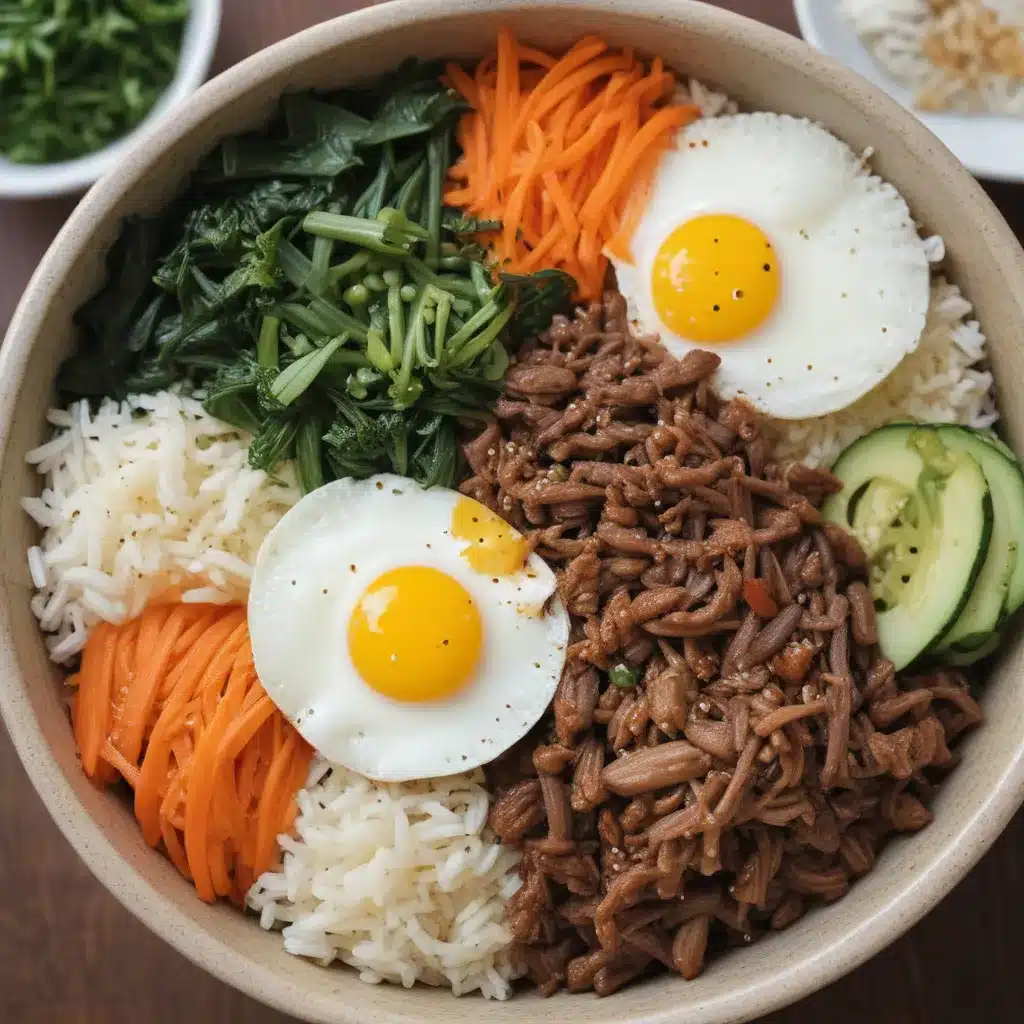
Bibimbap: The Ultimate Korean Bowl of Goodness
I’ll admit it – I’m a little obsessed with bibimbap. There, I said it! Honestly, how can you not be completely smitten with this iconic Korean rice bowl? It’s a flavor explosion, a veritable kaleidoscope of colors and textures that awakens every single taste bud. From the savory-sweet marinated beef to the crunchy, seasoned veggies, all brought together by that oh-so-addictive gochujang sauce – it’s a symphony in a bowl.
You see, I’m a self-proclaimed bowl food aficionado. I’ve had my fair share of grain bowls, noodle bowls, and every kind of bowl in between. But when it comes to true bowl food perfection, bibimbap reigns supreme. There’s just something so satisfying about that perfect blend of ingredients, each contributing its own unique taste and texture to create a harmonious whole.
And the best part? Bibimbap is not only delicious, but it’s also incredibly versatile and customizable. Whether you’re a meat-lover or a plant-based devotee, there’s a version of this dish that will have you coming back for more. So, let’s dive in and explore the secrets to building the ultimate bibimbap bowl, shall we?
The Humble Rice Bowl, Elevated
Now, you might be wondering, “What’s so special about a simple rice bowl?” Well, my friends, let me tell you – in the hands of the Koreans, the humble rice bowl becomes a culinary masterpiece. Bibimbap is the proof in the pudding, or should I say, the proof in the bowl.
The beauty of bibimbap lies in its balance of flavors and textures. It’s a symphony of salty, sweet, spicy, and umami notes, all coming together in perfect harmony. The foundation is a bed of warm, fluffy rice, which serves as a canvas for an array of meticulously prepared toppings.
First, you’ve got your seasoned vegetables – think crunchy carrots, tender spinach, earthy mushrooms, and crisp bean sprouts, all lightly seasoned to showcase their natural flavors. Then, there’s the protein component, usually in the form of thinly sliced marinated beef or juicy, seasoned chicken. And let’s not forget the star of the show – the signature gochujang sauce, a spicy-sweet-savory concoction that ties the whole dish together.
But the real magic happens when you take that first bite, mixing everything together until the yolk of the perfectly cooked egg seeps into the rice, creating a rich, creamy base for all the other flavors to dance upon. It’s a symphony of textures and tastes, a true culinary masterpiece in a humble bowl.
Mastering the Art of Bibimbap
Now, I know what you’re thinking – “Bibimbap sounds amazing, but it must be incredibly complicated to make, right?” Well, fear not, my friends, because I’m here to let you in on the secrets to mastering this Korean classic.
The key to building a killer bibimbap bowl is all about prepping the individual components. Sure, it might take a bit more time and effort than your average one-pot wonder, but trust me, it’s so worth it. Plus, the great thing about bibimbap is that you can make everything in advance and simply assemble the bowl when you’re ready to eat.
Let’s start with the base – the rice. Now, I know what you’re thinking, “How hard can rice be?” But let me tell you, the perfect bibimbap rice is the foundation upon which the entire dish is built. You want it to be fluffy, slightly sticky, and just the right temperature to marry with all the other components.
Next, let’s talk about the toppings. This is where you can really let your creativity shine. The traditional route is to have a variety of seasoned vegetables, like the ones I mentioned earlier, but feel free to get adventurous. Swap in your favorite greens, experiment with different mushroom varieties, or add a touch of crunch with some toasted sesame seeds.
And of course, we can’t forget about the star of the show – the gochujang sauce. This spicy-sweet Korean condiment is the glue that holds the whole dish together. Once you’ve mastered the art of making this versatile sauce, you’ll find yourself drizzling it on everything from roasted veggies to grilled chicken.
Bringing it All Together
Now that you’ve got all the individual components prepped and ready to go, it’s time to assemble your masterpiece. Start with a generous scoop of that perfectly cooked rice, then arrange your toppings in a visually appealing way. The key is to create a beautiful, colorful bowl that’s just begging to be mixed up.
And that’s where the real fun begins. Grab your chopsticks (or a fork, if you must) and start mixing everything together. Swirl the gochujang sauce through the rice, allowing it to soak in and mingle with the other flavors. Then, take a bite, making sure to get a little bit of everything in that first glorious mouthful.
I promise, the first bite will transport you straight to the heart of Korea. The savory-sweet notes of the beef, the crunchy-fresh veggies, and that irresistible gochujang sauce – it’s a symphony of flavors that’ll have you hooked from the very first taste.
So, what are you waiting for? Grab your apron, gather your ingredients, and let’s get to work on building the ultimate bibimbap bowl. Trust me, your taste buds will thank you.
